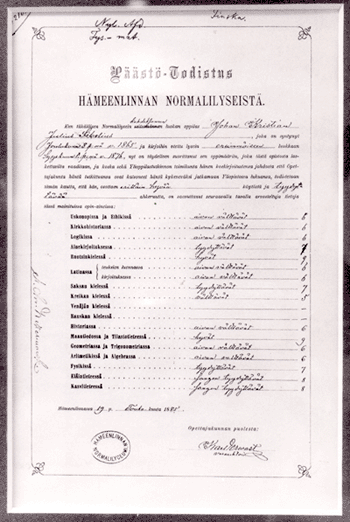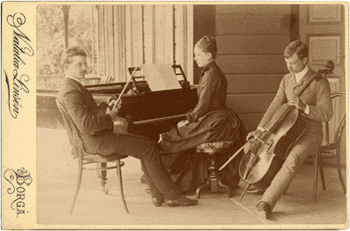Janne's main instrument changed from the piano to the violin around the start of the 1880s. He had the gift of perfect pitch, but his ear was accustomed to the low tuning of the square piano at home. Sibelius later recalled that when the family bought a piano with regular tuning, he felt alienated from the instrument and moved over
"to the violin side".
In the autumn of 1881, Janne, who was then nearly 16 years old, at last received proper music lessons, as a pupil of the bandmaster, Gustaf Levander. But even before the lessons began, the boy’s musical interests were severely affecting his schoolwork: in the summer of 1881 he had been given a decent violin by his Uncle Pehr in Turku, and he neglected the Latin that was obligatory for the school examinations. He had to repeat the fifth form.

Sibelius's leaving certificate from Hämeenlinna Normal Lyceum
However, he made rapid progress with the violin. Sibelius and his siblings formed a trio in which Janne played the violin, Linda the piano and little brother Christian the cello.

Janne, Linda and Christian Sibelius playing as a trio at the spa casino of Loviisa.
In December 1881, Janne joined the school orchestra where he played second violin. Soon he was also playing in a quartet of local amateurs. Their repertoire included quartets by Haydn and compositions by Schubert and Mendelssohn.
Several biographies claim that Janne wrote his first composition, Vattendroppar
(Raindrops) around 1875-1876. The work is a miniature for cello and violin in the style of the Viennese classical school. However, most researchers now believe that the work was written in the early 1880s and that it could be a small pizzicato exercise for Janne and his brother Christian, who had started playing the cello.
In a letter dating from the spring of 1883, Sibelius wrote that he had begun to study harmony. He added,
"I have mainly played the piano in order to learn to read music, as my uncle told me to."
The first mention of a composition can be found in a letter Sibelius wrote from Kalalahti, 25th August 1883. He disclosed that he had composed a trio and was working on another.
"They are rather poor, but it is nice to have something to do on rainy days," he wrote. The extant trio is the first of Sibelius’s compositions that can be dated with certainty.
Sibelius wrote his earliest works to be played by family members. In these early works, critics have been seen influences from the Viennese classical school, and later from Tchaikovsky and Grieg in particular.
In February 1884, Janne got hold of Johann Christian Lobe's work Lehrbuch der musikalischen Composition, which he called Compositionslehre in a letter to Uncle Pehr. If Sibelius really did wade through the book, he must have acquired a knowledge of musical theory that was exceptional for a youth of his age. Following Lobe's teachings, Sibelius composed a piano quartet and a piano trio.
Composing was now taking so much of his time that it harmed his performance at school. Yet despite the fears of the family, Janne was able take his matriculation examination in the spring of 1885. His essay from the examination has been preserved: it shows that his school Finnish was quite good and that he was interested in the reign of the Swedish king, Gustav III (reigned 1771-1792).
In his letters, Sibelius seems to be considering the career of an apothecary or a clerk, but –encouraged by his maternal uncle Axel Borg – he enrolled in the Faculty of Law at Helsinki University. The family did not wish to hinder his musical pursuits, so in addition, he was allowed to register as a special student at the conservatoire.

